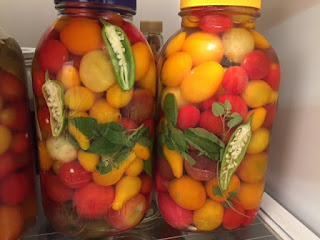There is a lot to love about a cantaloupe. Start with that fragrance. It perfumes the garden air long before the visitor reaches the vines, which, unlike cucurbit cousins Pumpkin, Cucumber and Gourd, grow compactly and make weeding a manageable task. The perky blossoms are bright yellow and attract a host of pollinators to their stamens. And, then, of course, there is the flavor. Summer gold on the tongue, to be sure.
 |
| The RUTH, a special heirloom cantaloupe |
So, why did I never grow cantaloupe before this year? Although I hate to admit it, cantaloupe has never been my favorite food. As a matter of fact, it is one of the very few foods I typically avoid. All that changed when my cousin, Ruth Bolick, mailed some heirloom cantaloupe seeds to my home and I planted a hill this spring. After diligently weeding and caring for the plants, my reward was four beautiful melons.
 |
| Ruth's cantaloupes in late spring |
Just after the orbs swelled to about softball size, I took the cap off a ball point pen and carefully scratched the surface of two melons. R U T H. The lines of the letters oozed and left faint marks which healed and became more apparent as the melons matured.
On harvest day, I placed the four cantaloupes in a box and drove them home, noting the two bearing Ruth's name were unblemished, unlike the others, which hosted soft spots and dark marks. When I sliced one of the blemished melons, I expected to find a rotten center, but to my surprise, the interior was firm, richly colored and deliciously juicy. I carefully scraped seeds from the center, peeled and sliced the cantaloupe and stored it in the refrigerator after sneaking several bites.
Packing the two "named" melons in a cardboard box, I called Ruth and told her I was planning to deliver a present. She rewarded me with a bright smile as she lifted a melon to her face to inhale the fragrance. We chatted and compared gardening notes and she offered instructions about saving cantaloupe seeds, which her mother taught her to do.
 |
| Cousin Ruth holds her namesake melon |
|
|
Heirloom fruits and vegetables are true treasures, not only for longevity, but for incomparable flavor. After tasting Ruth's cantaloupes, I am now a fan and the following recipe offers an easy preparation that highlights the melon's sweetness while salty Prosciutto and smoky Chipotle pepper provide flavor balance. Serve it as a side dish or appetizer. Bonus points for using heirloom cantaloupe!
 |
| Cantaloupe + Prosciutto + Chipotle = Delicous |
Roasted Cantaloupe Bites Wrapped in Prosciutto
6 servings
Preheat oven to 375 degrees.
Peel and cut ripe cantaloupe into 12 2-inch cubes.
In a small bowl, combine the following:
2 tablespoons brown sugar
1/2 teaspoon cumin
1/2 teaspoon cinnamon
1/4 teaspoon grated nutmeg
1/4 teaspoon Chipotle powder
Toss melon cubes in mixture and rub to coat.
Use a sharp knife to cut 4 slices Prosciutto into 1/2 inch lengths.
Wrap melon cubes with Prosciutto, crossing to form an "X" pattern.
Line a baking sheet with foil and drizzle olive oil lightly over foil.
Place wrapped melon on baking sheet and bake in preheated oven for 8 minutes, turning melon at the 4 minute mark.
Turn oven to broil and broil melon for one minute, then flip to broil the other side.
Serve warm and, for those with a sweet tooth, lightly drizzle with honey before serving.





















